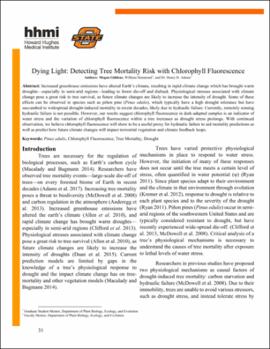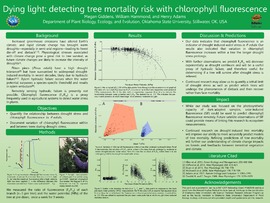| dc.contributor.advisor | Hammond, William | |
| dc.contributor.advisor | Adams, Henry D. | |
| dc.contributor.author | Giddens, Megan | |
| dc.contributor.other | HHMI Life Science Freshman Research Scholars | |
| dc.date.accessioned | 2019-07-22T17:02:56Z | |
| dc.date.available | 2019-07-22T17:02:56Z | |
| dc.date.issued | 2019-04-27 | |
| dc.identifier | oksd_hhmi_2019_giddensM | |
| dc.identifier | oksd_hhmi_2019_giddensM_poster | |
| dc.identifier.citation | Giddens, M., Hammond, W., & Adams, H. D. (2019, April 27). Dying light: Detecting tree mortality risk with chlorophyll fluorescence. Paper presented at the HHMI Life Science Freshman Research Scholars Symposium, Stillwater, OK. | |
| dc.identifier.uri | https://hdl.handle.net/11244/321040 | |
| dc.description.abstract | Increased greenhouse emissions have altered Earth's climate, resulting in rapid climate change which has brought warm droughts-especially in semi-arid regions-leading to forest die-off and dieback. Physiological stresses associated with climate change pose a great risk to tree survival, as future climate changes are likely to increase the intensity of drought. Some of these effects can be observed in species such as pinon pine (Pinus edulis), which typically have a high drought tolerance but have succumbed to widespread drought-induced mortality in recent decades, likely due to hydraulic failure. Currently, remotely sensing hydraulic failure is not possible. However, our results suggest chlorophyll fluorescence in dark-adapted samples is an indicator of water stress and the variation of chlorophyll fluorescence within a tree increases as drought stress prolongs. With continued observation, we believe chlorophyll fluorescence will show to be a useful proxy for hydraulic failure to aid mortality predictions as well as predict how future climate changes will impact terrestrial vegetation and climate feedback loops. | |
| dc.description.sponsorship | Howard Hughes Medical Institute Science Education Program | |
| dc.format | application/pdf | |
| dc.language | en_US | |
| dc.publisher | Oklahoma State University | |
| dc.rights | In the Oklahoma State University Library's institutional repository this paper is made available through the open access principles and the terms of agreement/consent between the author(s) and the publisher. The permission policy on the use, reproduction or distribution of the article falls under fair use for educational, scholarship, and research purposes. Contact Digital Resources and Discovery Services at lib-dls@okstate.edu or 405-744-9161 for further information. | |
| dc.title | Dying light: Detecting tree mortality risk with chlorophyll fluorescence | |
| osu.filename | oksd_hhmi_2019_giddensM.pdf | |
| osu.filename | oksd_hhmi_2019_giddensM_poster.pdf | |
| dc.description.department | Plant Biology, Ecology and Evolution | |
| dc.type.genre | Research report | |
| dc.type.genre | Presentation | |
| dc.type.material | Text | |
| dc.subject.keywords | pinus edulis | |
| dc.subject.keywords | chlorophyll fluorescence | |
| dc.subject.keywords | tree mortality | |
| dc.subject.keywords | drought | |

